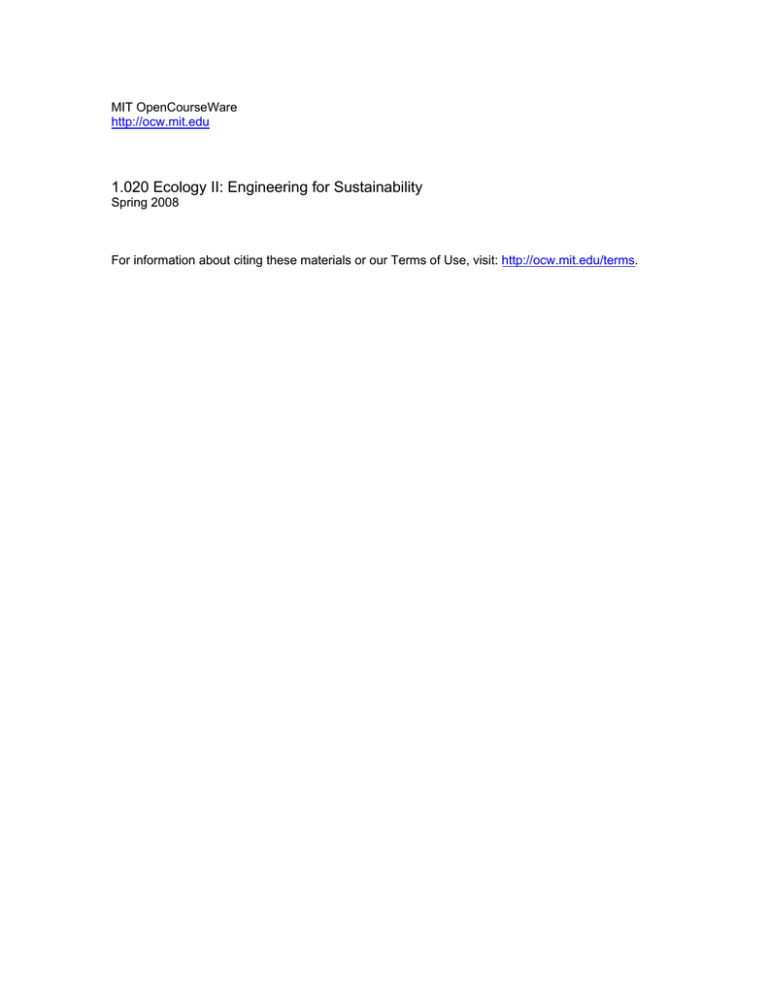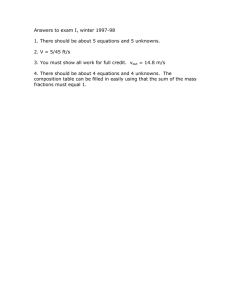1.020 Ecology II: Engineering for Sustainability MIT OpenCourseWare Spring 2008
advertisement

MIT OpenCourseWare http://ocw.mit.edu 1.020 Ecology II: Engineering for Sustainability Spring 2008 For information about citing these materials or our Terms of Use, visit: http://ocw.mit.edu/terms. Lectures 08_6 & 08_7 Outline: Networks, Traffic Modeling Motivation/Objective Develop a model to compute atmospheric (CO) emissions rates from vehicles on a road network Approach 1. Formulate mathematical description of system (road network: nodes, directed links, paths). 2. Select variables to describe steady-state vehicle movement through the network. Identify unknowns (link flow rates x l and link travel times t l ). 3. Formulate coupled equations that use linear travel-time functions, mass balance conditions, and a user equilibrium condition to relate unknown flows and travel times. 4. Specify network properties, solve equations for unknowns (MATLAB) 5. Relate emissions rate to network variables, examine effect of network properties on emissions Concepts and Definitions: Networks: Represent with nodes, directed links, and paths. Describe connectivity, specify link lengths. Steady-state condition: Flow into network = flow out of network. -1 Conditions used to relate link travel times t l (hr) and vehicle flow rates xl (vehicles hr ): βl • Link travel-time functions: t l = f ( xl ) = t 0 + α l xl ( β l = 1 ) for the example. • Mass balance at nodes: sum of xl for links entering node = sum of xl for links leaving node. User equilibrium condition: path travel times are equal for all possible paths • for link l . Asume t l = f ( xl ) is linear Each conditions generates linear equations in the unknown link times and flows. Emissions: Used to compute source rate of pollutant to atmosphere (g km-1 hr-1) from each link El (vl ) = xl cl (vl )γ l (vl ) , cl (vl) = consumption, γ l (vl) = production rate, vl = xl / t l = vehicle velocity Network balance eqs: Assemble the three types of linear equations in a matrix form and solve with MATLAB: ⎡ Atravel ,t Atravel , x ⎤ ⎡ t ⎤ ⎡btravel ⎤ ⎢ ⎥⎢ ⎥ ⎢ ⎥ ⎢ Amass ,t Amass , x ⎥ ⎢ ⎥ = ⎢ bmass ⎥ , t and x are vectors of link travel times and flows ⎢ Aequil ,t Aequil , x ⎥ ⎢⎣ x ⎥⎦ ⎢⎣ 0 ⎥⎦ ⎣ ⎦ Model Results Note effect of fuel consumption and CO production rate on CO emissions pattern. Examine changes in network geometry and Braess’ paradox.

